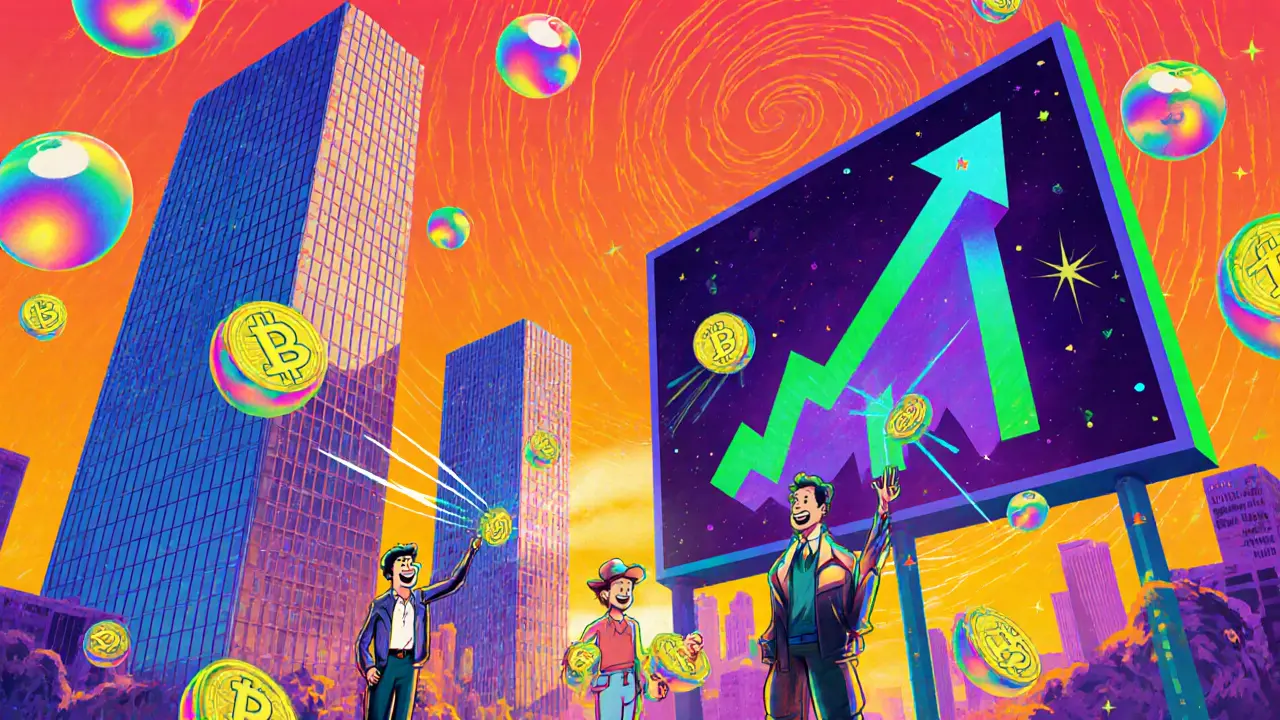Fractional Real Estate Investment Calculator
How much do you need to invest?
Calculate your minimum investment for fractional real estate ownership based on property value and your desired ownership percentage.
Imagine buying a slice of a downtown office building for the price of a coffee. real estate tokenization makes that possible by turning bricks and mortar into digital tokens you can trade 24/7. This article breaks down what Real Estate RWA Tokenization is, how it works on the blockchain, why it matters, and what you need to watch out for before diving in.
- RWA tokenization converts physical property into fractional blockchain tokens.
- Typical workflow: asset vetting → legal SPV → ERC‑20 minting → smart contracts → marketplace.
- Benefits include lower entry barriers, instant liquidity, and transparent earnings.
- Key risks involve regulatory uncertainty, liquidity limits, and technical scalability.
- Global market could exceed $2 trillion by 2030 if standards converge.
What is Real Estate RWA Tokenization?
Real Estate RWA Tokenization is a process that digitizes a physical property into blockchain‑based tokens, each representing a fractional ownership stake. The tokens are backed by a legal wrapper-usually a Special Purpose Vehicle (SPV)-that holds title to the real‑world asset. Investors buy and sell those tokens just like cryptocurrencies, but the underlying value comes from rent, appreciation, or sale proceeds of the property.
This model mirrors a private company’s IPO: the SPV issues shares (tokens) to raise capital, and token holders earn dividends automatically via smart contracts. The rapid growth of tokenized assets-over $13.5 billion by the end of 2024 and projected to hit $2 trillion by 2030-shows why the market is buzzing.
Technical Architecture: The Building Blocks
Behind every token sits a stack of blockchain tech. Most projects today choose Ethereum because of its mature developer ecosystem and support for the ERC‑20 token standard. ERC‑20 defines how fungible tokens behave-how they transfer, balance, and approve spending-making it ideal for representing identical ownership slices.
To bridge off‑chain property data with on‑chain logic, platforms rely on Chainlink oracles. These oracles pull valuation metrics, rental income, and compliance checks into smart contracts, ensuring payouts match real‑world cash flow.
The core smart contract encodes three rules:
- Dividends are distributed proportionally when rent is collected.
- Transfer restrictions enforce KYC/AML compliance.
- Token burn or buy‑back mechanisms handle property sales.
Platforms like Brickken and Mintology provide turnkey solutions that bundle these components, from SPV creation to token minting.
Step‑by‑Step Tokenization Workflow
Turning a building into tokens follows a repeatable five‑step process:
- Asset Selection: Choose a property class-commercial office, residential complex, or development project. Commercial assets dominate early adoption because they generate steady cash flow.
- Legal Structure Creation: Form an SPV (often a limited liability company) that legally owns the property. The SPV’s share class is linked to the digital token.
- Token Minting: Deploy an ERC‑20 contract on Ethereum (or a compatible layer‑2) that mints a fixed supply, e.g., 100,000 tokens each representing 0.001 % ownership.
- Smart Contract Setup: Encode dividend distribution, compliance checks, and transfer rules. Oracles like Chainlink feed rent data into the contract.
- Token Distribution: List the tokens on a compliant marketplace-such as Brickken’s token exchange or a regulated secondary platform-where investors can buy, sell, or trade 24/7.
According to Mintology’s 2024 guide, the off‑chain legal phase consumes roughly 60‑70 % of total lead time, meaning a typical commercial project takes 90‑150 days from start to first token sale.

Benefits vs. Traditional Property Investment
Tokenization tackles three pain points of classic real‑estate investing: high capital requirements, illiquidity, and opaque reporting. Below is a side‑by‑side look.
| Aspect | Tokenized Real Estate (RWA) | Traditional Direct Purchase | REITs |
|---|---|---|---|
| Minimum Investment | $1,000 (single token) | $100,000‑$1 M (full ownership) | $500‑$5,000 (shares) |
| Liquidity | 24/7 secondary markets, settlement in minutes | Months‑to‑years to sell | Daily trading on stock exchanges |
| Transparency | Blockchain ledger shows every transfer, dividend, and audit trail | Periodic statements, limited public data | Regulatory filings, but less granular than token ledger |
| Intermediary Costs | 0.5‑2.5 % annual management fee (platform‑based) | 3‑6 % broker & legal fees upfront | 0.5‑2 % expense ratio |
| Regulatory Exposure | Varies by jurisdiction; often falls under securities law | Local property law, zoning, taxes | Well‑established security regulations |
These numbers show why investors can start with as little as $1,000 and still earn quarterly dividends-something that would require a full‑scale property purchase otherwise.
Risks & Regulatory Landscape
Despite the upside, tokenization is not risk‑free. The World Economic Forum notes that only 37 % of global markets have clear RWA frameworks, leading to fragmented compliance requirements. Key risk categories include:
- Regulatory Uncertainty: Some jurisdictions treat tokens as securities, others as commodities. The EU’s MiCA regulation (effective Dec 2024) is the first comprehensive rulebook, but the U.S. SEC still issues case‑by‑case guidance.
- Liquidity Constraints: Secondary markets exist, but depth varies. Early platforms reported lock‑up periods up to 90 days, limiting rapid exit.
- Technical Scalability: Ethereum’s 15‑30 TPS limits peak‑hour trading. Layer‑2 solutions (e.g., Optimism, zkSync) are emerging but add complexity.
- Legal Enforceability: Token holders own shares in an SPV, not the title itself. If SPV governance fails, investors may face challenges asserting rights.
Smart‑contract audits, reputable custodial partners, and jurisdictions with clear token‑friendly laws (Switzerland, Singapore, Wyoming) mitigate many of these concerns.

Market Landscape & Future Outlook
Tokenized real‑estate assets hit $13.5 billion in 2024, a 60 % YoY increase. Analysts at McKinsey forecast a $2 trillion market by 2030, with commercial properties accounting for roughly 45 % of tokenized volume. Institutional players are leading the charge: JPMorgan piloted tokenized mortgages in 2023, BlackRock added commercial tokens to its BUIDL fund in 2024, and Fidelity filed a real‑estate token fund in early 2024.
Geographically, Switzerland, the UAE, Singapore, and U.S. states like Wyoming dominate due to clear legal pathways. The upcoming launch of regulated secondary exchanges-such as SIX Digital Exchange’s 2025 real‑estate token market-will address liquidity gaps and bring institutional confidence.
Looking ahead, three trends will shape the space:
- Standardization: The Blockchain Association’s Real Estate Tokenization Standard (RETS) aims to harmonize valuation, reporting, and audit practices.
- Interoperability: Cross‑chain bridges (Ethereum ↔ Polygon, Solana) will let investors move tokens without swapping assets.
- CBDC Integration: Fourteen countries plan to accept central‑bank digital currencies for token settlement, cutting conversion fees.
Gartner places real‑estate tokenization on the “Slope of Enlightenment,” signaling mainstream adoption around 2027‑2030 once regulatory harmonization solidifies.
Getting Started: Practical Checklist for Investors
- Define Your Goal: Income (rental yield) vs. appreciation vs. diversification.
- Pick a Reputable Platform: Look for audited smart contracts, clear SPV structure, and transparent fee tables (e.g., Brickken, Mintology).
- Verify Legal Jurisdiction: Ensure the token complies with local securities law and that the SPV is recognized.
- Understand Token Economics: Total supply, dividend schedule, lock‑up periods, and secondary market options.
- Complete KYC/AML: Most platforms require identity verification before purchase.
- Fund Your Wallet: Load ETH or a supported stablecoin to cover token price and gas fees.
- Monitor Oracle Sources: Confirm that rent data feeds (often via Chainlink) are reliable.
- Plan Exit Strategy: Identify liquidity venues-dedicated exchanges, OTC desks, or peer‑to‑peer trades.
By ticking these boxes, you reduce surprises and can focus on the core benefit: earning passive income from real‑world property without ever stepping foot inside.
What does a token actually represent in a real‑estate RWA?
Each token is a digital share of an SPV that legally owns the property. The token holder owns a proportionate claim on rental income and any sale proceeds, recorded immutably on the blockchain.
Can I sell my tokens instantly?
If the token is listed on a compliant secondary market, you can trade it 24/7. Liquidity depends on market depth and any platform‑imposed lock‑up periods.
What fees should I expect?
Platforms typically charge an upfront implementation fee ($75k‑$250k for the asset) plus an annual management fee of 0.5‑2.5 % of the tokenized asset’s value. Transaction gas fees also apply.
Is my investment protected by traditional property law?
Your rights flow from the SPV’s legal structure. If the SPV is properly chartered, token holders have the same claim as shareholders in a corporation, subject to local corporate law.
How are dividends paid?
Smart contracts automatically calculate each holder’s share of rental income and execute payments-usually in stablecoins-within a few business days of cash collection.

Write a comment